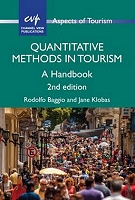|
| Turismo | IT & Internet | Pagine Sparse | Astronomia | Curriculum |
Tourism studies often deal with complex mixes of external and local factors and the attitudes, perceptions and actions of tourists themselves. In seeking to understand individual elements of this mix, or the results of interactions between them, tourism authorities, managers and researchers often collect quantitative data, but until now the few existing guides to understanding quantitative data have been either very simple or very complicated. This book provides a guide to dealing with real-world data and goes beyond the methods usually covered in introductory textbooks. Each chapter includes extensive references to additional reading, and an appendix summarises the software introduced in the book. In this revised second edition, we build upon the work of the previous volume, offering an updated presentation of quantitative research methods for tourism researchers and consider useful techniques for statistical inquiry into tourism matters of all but the most econometrically complex kind. The first part of the book concerns common issues in statistical analysis of data and the most widely-used techniques, while the second part describes and discusses several newer and less common approaches to data analysis that are valuable for tourism researchers and analysts. Part 1: The Analysis of Data An excellent practical guide for researchers, analysts, industry consultants and students, providing a rigorous yet readable account of standard and new quantitative statistical applications in tourism contexts. This usable reference book deserves a prominent place on every tourism scholar’s bookshelf. With wide coverage of quantitative approaches and practical examples in tourism, this book walks readers through the essentials of quantitative methods that are required to keep pace with the fast-changing tourism industry. The book provides a thorough review of quantitative techniques and addresses pressing issues such as “Big Data”, making it a must-read reference for researchers, educators, practitioners, and students. New material in the second edition of this handbook includes a chapter on big data and updated coverage of agent-based modelling. Illustrated throughout with a variety of well-chosen examples pertaining to a wide range of tourism topics, this is an essential addition to the book shelves of all tourism graduate students and researchers. Read an excerpt (pdf file) More info: Publisher's website
|
 QUANTITATIVE METHODS IN TOURISM
QUANTITATIVE METHODS IN TOURISM